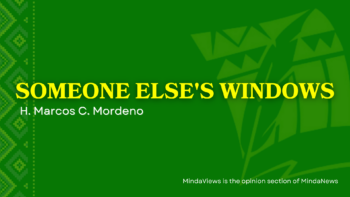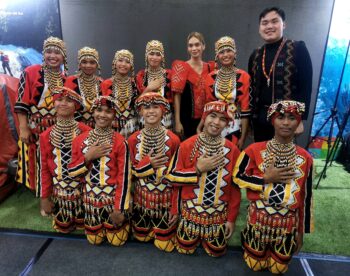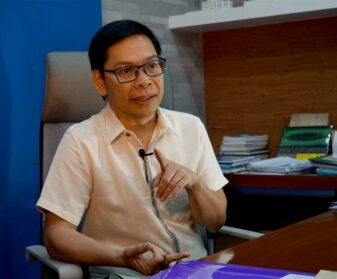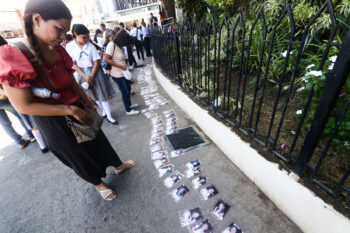4th of a six-part series
*This six part series is based on an article I wrote with Atty. Janice Lee entitled “The Draft Bangsamoro Basic Law: Overcoming Constitutional Challenges” which Ateneo de Davao University just published in a Compendium on the Draft Bangsamoro Basic Law.
CAGAYAN DE ORO CITY (MindaNews/13 March) — The draft BBL defines “territory” as land mass as well as the maritime, terrestrial, fluvial and alluvial domains, and the aerial domain above it. In order to obviate any speculation, the draft BBL also emphasizes that the Bangsamoro territory shall remain a part of the Philippines.
Under Section 2, Article III of the draft BBL, the Bangsamoro core territory is as follows:
- the present geographical area of the Autonomous Region in Muslim Mindanao;
- the Municipalities of Baloi, Munai, Nunungan, Pantar, Tagoloan and Tangkal in the province of Lanao del Norte and all other barangays in the Municipalities of Kabacan, Carmen, Aleosan, Pigkawayan, Pikit and Midsayap that voted for inclusion in the ARMM during the 2001 plebiscite;
- the cities of Cotabato and Isabela; and
- all other contiguous areas where there is resolution of the local government unit or a petition of at least ten percent (10%) of the registered voters in the area asking for their inclusion at least two months prior to the conduct of the ratification of the Bangsamoro Basic Law and the process of delimitation of the Bangsamoro.
The areas which are contiguous and outside the core territory may opt at anytime to be part of the territory upon petition of at least ten percent (10%) of the registered voters and approved by a majority of qualified votes cast in a plebiscite.
Sections 4, Article III of the draft BBL provide that the Bangsamoro Government (BG) shall have jurisdiction over the preservation and management of all inland waters within the Bangsamoro territory. As to the Bangsamoro Waters, this is defined under Section 5 as extending “up to 22.224 kilometers (12 nautical miles) from the low-water mark of the coasts that are part of the Bangsamoro territory. The Bangsamoro Waters shall be part of the territorial jurisdiction of the Bangsamoro political entity. Inland waters and inland waterways for navigation are also part of the exclusive powers of the Bangsamoro Government.
It is submitted that what is actually contemplated in the provisions on territory with respect to the Bangsamoro is more properly termed as the territorial jurisdiction of the Bangsamoro Government. As such, it does not pertain to ownership of these territories, in contravention of Article I of the Constitution on the National Territory, or Section 2, Article XII thereof, which provides that all land of the public domain, including waters, belong to the State. As stated earlier, the draft BBL stresses that the territory remains to be part of the Philippines. The same may also be said with respect to the jurisdiction of the BG over waters, whether inland or not.
As to natural resources, Section 8, Article XIII of the draft BBL provides: “The Bangsamoro Government shall have the authority, power, and right to explore, develop and utilize the natural resources, including surface and sub-surface rights, inland waters, coastal waters, and renewable and non-renewable resources in the Bangsamoro.:
Paragraph 29, Section 3, Article V of the draft BBL also places “ancestral domain and natural resources” under the exclusive powers of the BG. It is only the exploration, development, and utilization of fossil fuels and uranium which are exercised jointly by the BG and the Central Government (CG).
These provisions may be seen as running counter to Article XII, Section 2 of the Constitution, which provides: “All lands of the public domain, waters, minerals, coal, petroleum, and other mineral oils, all forces of potential energy, fisheries, forests or timber, wildlife, flora and fauna, and other natural resources are owned by the State. With the exception of agricultural lands, all other natural resources shall not be alienated. The exploration, development, and utilization of natural resources shall be under the full control and supervision of the State.”
In many decisions, Section 2, also known as the Regalian doctrine, has been parsed by the Supreme Court as follows: (1) All natural resources are owned by the State. Except for agricultural lands, natural resources cannot be alienated by the State; (2) The exploration, development and utilization (EDU) of natural resources shall be under the full control and supervision of the State; (3) The State may undertake these EDU activities through either of the following – (a) By itself directly and solely(b); By (i) co-production; (ii) joint venture; or (iii) production sharing agreements with Filipino citizens or corporations, at least 60 percent of the capital of which is owned by such citizens. Moreover, small-scale utilization of natural resources may be allowed by law in favor of Filipino citizens while for large-scale EDU of minerals, petroleum and other mineral oils, the President may enter into “agreements with foreign-owned corporations involving either technical or financial assistance according to the general terms and conditions provided by law.”
In this light, Section 8, Article XIII of the draft BBL which provides that the BG shall “have the authority, power and right” to the EDU of natural resources may be taken to be beyond the allowable scope of the Constitution. The “state” which is referred to in Section 2, Article XII of the Constitution is undeniably the Central Government. Any EDU of natural resources within its territory must conform to the parameters of the Constitution. What may, however, be allowed to members of the Bangsamoro is the small-scale utilization of natural resources, which may be granted to Filipino citizens. This is an example of what may be regulated by the BG in the exercise of its legislative powers over natural resources. It is suggested that a revision of these provisions delineating the powers of the BG over natural resources may be helpful in order to avoid any successful challenge to the constitutionality of the BBL.
An example of a suggested revision of Section 8, on Natural Resources, Nature Reserves and Protected Areas, may be as follows: “The Bangsamoro Government shall have the legislative authority to regulate the exploration, development and utilization of natural resources, including surface and sub-surface rights, inland waters, coastal waters, and renewable and non-renewable resources in the Bangsamoro. This shall be without prejudice to the exercise of full control and supervision by the Central Government of such exploration, development and utilization.”
Alternatively, the provision may also be amended to reflect the delegation of authority from the State to the Bangsamoro Government, thus: “The control and supervision over the exploration, development and utilization of natural resources, including surface and sub-surface rights, inland waters, coastal waters, and renewable and non-renewable resources in the Bangsamoro is hereby delegated to the Bangsamoro Government in accordance with the Constitution and national laws. This shall be without prejudice to the exercise of full control and supervision by the Central Government of such exploration, development and utilization.”
(MindaViews is the opinion section of MindaNews. Dean Tony La Viña is a human rights and environmental lawyer from Cagayan de Oro City. He was a member of the Government of the Philippines Peace Panel that negotiated with the MILF from January-June 2010. He is currently the Dean of the Ateneo School of Government. Dean Tony can be reached at Tonylavs@gmail.com. Follow him on Facebook: tlavina@yahoo.com and on Twitter: tonylavs.)
Tomorrow: Strengthening the BBL provisions on indigenous peoples







